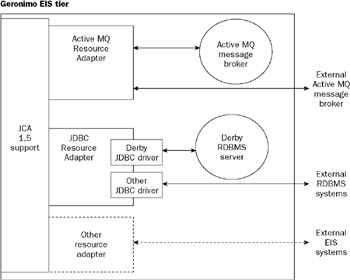The EIS Tier
The EIS (Enterprise Information Systems) tier of the J2EE model is all about interfacing to external systems. More specifically, this tier contains technologies and software components that are used to connect to other systems in the enterprise.
The types of EIS systems to which you might need a connection include:
-
Relational database management system (Oracle, DB 2, PostgreSQL, MySQL, and so on)
-
Message queue system (MQ series, ActiveMQ, and so on)
-
Legacy system (mainframe computers, minicomputers)
At the EIS tier, the main objective is to allow the J2EE software components to interact and leverage external systems. It must be flexible and adaptive in the integration of these additional systems, both present and future. This tier is the portal from the J2EE server into other enterprise assets (data, computing capabilities, and so on) that are not available within the pure Java environment.
The J2EE solution to this problem is to enable plug-ins. The concept is familiar. Instead of having very specific ability to connect to very specific systems, J2EE provides a connector architecture - a driver interface, if you will. Basically, any vendor or developer then can write a connector (driver) that plugs into the EIS tier to access any external system. The only requirement for the connector/driver is that it is written to the Java Connector Architecture (JCA) 1.5 standard.
This strategy has been proven to be very effective. To access relational databases, a JDBC connector is supplied in Geronimo. This connector has the unique ability to work with any JDBC-complaint drivers, allowing applications in Geronimo to talk to major RDBMSs (such as Oracle, DB2, PostgreSQL, and MySQL) right out of the box.
Another important connector that is supplied in Geronimo is the ActiveMQ JCA 1.5 resource adapter. This connector allows applications running on Geronimo to access message queues (MQs) handled by the ActiveMQ message broker via the standard JMS APIs. To connect to other MQ systems, this can be done indirectly through ActiveMQ, or via a JCA 1.5 connector for the target MQ system.
The capability to interface to legacy systems, although logically belonging to the EIS tier, is classified as part of container services - interoperation. The main enabling technology here is the capability to talk to CORBA-based systems.. The Interoperability tier is discussed later in this chapter.
Figure 4-4 shows the components associated with JCA 1.5 support at Geronimo’s EIS tier.

Figure 4-4: Geronimo’s JCA 1.5 and EIS tier services
The following section describes the components depicted in Figure 4-4.
ActiveMQ at the EIS Tier
Geronimo integrates ActiveMQ on the EIS tier in two ways:
-
The ActiveMQ JCA 1.5 resource adapter is available to access any ActiveMQ broker instance.
-
An instance of the ActiveMQ broker is configured as a service running in the default full J2EE Server download configuration of Geronimo.
An ActiveMQ resource adapter is a driver that can be used to access a message broker. An ActiveMQ message broker is the actual server that manages and coordinates the message queues.
With the JCA 1.5 resource adapter, application components deployed at the Web and business tiers have access to the message queue functionality provided by any ActiveMQ message broker. Developers can code to the well-known JMS APIs. Of course, the easiest broker to use will be the one hosted in Geronimo.
The instance of ActiveMQ message broker hosted in Geronimo can be configured directly through Geronimo (Web console or config.xml). Chapter 16, provides more details on configuration of ActiveMQ broker.
Derby at the EIS Tier
Geronimo has a built in JCA 1.5 connector for JDBC. This enables the application components at both the Web and business tiers to access any relational database that has JDBC support. Almost all of the major vendors (including Oracle, IBM DB2, Microsoft SQL Server, PostgreSQL, and MySQL) have excellent support for JDBC.
Geronimo also has its own built-in relational database system. Geronimo’s built-in server is an instance of an Apache Derby database. Apache Derby is a 100 percent Java implementation of a full-featured relational database system. Derby actually evolved from code donated by IBM. IBM continues to market a version of Derby called Cloudscape.
Developers code to the standard JDBC APIs. As an administrator, you can configure the Derby instance hosted by Geronimo. You can also configure data sources for software components via the JDBC connector for access to the internal Derby or another external RDBMS.
Chapter 13 will provide more details on the configuration of Geronimo data sources for external RDBMSs.
JavaMail for Integration to Email Systems
Another feature of Geronimo that logically belongs in the EIS tier is the JavaMail integration. JavaMail is a simple API for software components to work with email messages. Geronimo has an implementation of JavaMail built in and enables applications to access SMTP-based email servers. Developers can code their components to the standard JavaMail 1.3 APIs.
As an administrator, you may want to configure the Simple Mail Transfer Protocol (SMTP) server location(s). Chapter 12 has coverage on the configuration of JavaMail parameters for Geronimo.
EAN: 2147483647
Pages: 148